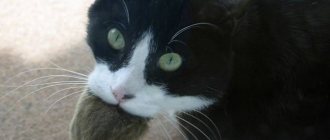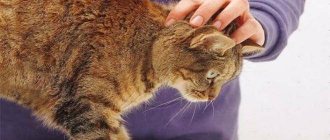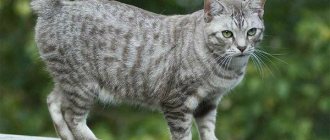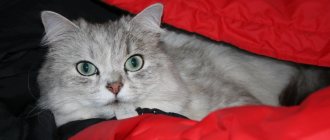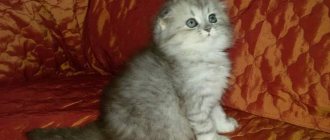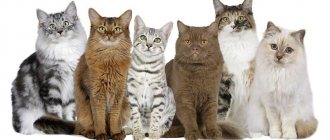Cats are predators.
And all predators have a hunting instinct inherent in them by nature. Nowadays, pets do not have an urgent need to hunt to find food. Therefore, not every breed has fully inherited its natural characteristics. Selection also played a role. For hunting cats, the main object of hunting was and remains rodents. But not every member of the cat family can kill rats. The ratcatcher cat receives these abilities at the genetic level, and also acquires the skill during the hunt.
How did the Kurilian Bobtail originate?
The breed appeared in the Far East, back in the days when this territory was quite isolated from external influence. The breed originated in the 19th century (at this time the first appearance of bobtails in human sight was recorded). The cats lived in prides and had no contact with humans. Local Kurilians began domesticating the breed, thanks to which Kurilian bobtails can now become pets of breeders around the world.
This is an aboriginal breed, and it originated in our country. Bobtails are completely natural in their habits.
They appeared on mainland lands only in the 50s; through selection, the breed was fixed at the genetic level, so it retains its characteristics to this day. Military geologists declared the existence of the Kuril Bobtail as an independent breed, but not everyone agreed that the Russian Bobtails are not descendants of the Japanese. The breed was noticed two centuries ago, but was recognized only in the 90s of the twentieth century.
Savannah
This breed was created by crossing a wild African cat and a domestic cat. The result was a pet that looked very similar to a cheetah. The breeding of unusual pets was carried out in the USA in the 80s of the last century. However, the breed was officially recognized only in 2001.
Savannah weighs 15 kilograms, and its height at the withers reaches 60 centimeters. The cat's fur is spotted and can be golden, chocolate or brown.
Of course, the Savannah is considered a domestic cat and it is quite possible to tame it. However, such a pet needs to be raised from birth. Otherwise, he will grow up disobedient and extremely wayward.
Savannah is especially energetic, so it needs to be walked regularly. When interacting with a cat, you need to be especially careful, since it is still a fairly large animal. She poses a threat to strangers. Because usually a cat only obeys its owner.
Features of the breed.
The Kurilian Bobtail has a short tail. It should be noted that it is like this by nature, it is not docked or circumcised.
Felinologists became interested in these cats when they were already living with people and catching not only mice, but also fish. The Kurilian Bobtail is the most intelligent of its brothers. Many people seriously say that he is closer to a dog in his characteristics.
Kuril cats appeared and developed on the islands, so they are not afraid of water. They enjoy fishing and swimming.
Representatives of this breed are highly trainable (like dogs). With regular training, the cat can be taught commands such as “sit”, “place”, “no” and so on. Experienced breeders say that the Kurilian bobtail is capable of understanding about one and a half thousand words and phrases. If you pay attention to raising a smoker from an early age, he will never tear up wallpaper, spoil furniture or play dirty tricks. The Kuril Islands, in principle, do not show vindictiveness or aggression. They are not vindictive, even if they have been punished by their owner. A very intelligent and non-conflicting pet, he gets along easily with other animals (even dogs) and is safe for children. He is especially sociable and friendly with animals of his own breed.
Kurilian Bobtails treat their offspring very carefully. Not only females, but also males look after the kittens. If a mother cat is unable for some reason to care for her offspring, then someone from a large pride of cats will take over her responsibilities. However, if the cat is alone in the house, she will not leave the kittens until she teaches them to hunt and other skills necessary for life. An adult pet will even teach how to use a litter tray and other amenities.
When breeding Kuril Bobtails, you need to take into account the fact that they have matriarchy. You shouldn’t be surprised if it’s the cat who plays the main role in the house, not the tomcat.
It is also very important to know that bobtails make more than just the usual “meow” sounds. Their range is much wider than that of a normal cat. They can produce sounds similar to bleats, squeaks and pigeon coos.
A cat of this breed MUST be brushed periodically with special brushes, since historically the breed was formed in the wild and has a thick undercoat. This is especially important for long-haired animals.
The Kurilian Bobtail is not afraid of water, bathing is of interest to them, BUT washing the cat still does not give pleasure, so you need to teach it to wash from an early age.
These animals lead an active lifestyle, know how and love to jump high and hunt. At home, you need to provide smokers with favorable conditions: various scratching posts, shelves, toys. It is desirable that the storage room be spacious (ideally a private house). Your pet can be walked on a leash designed for small breed dogs.
The diet for such a cat should be balanced. Lack of minerals and nutrients in the diet can lead to digestive disorders.
When choosing a Kurilian Bobtail as a pet, you should pay attention to its pedigree, because animals with admixture may be genetically different and may not exhibit the special qualities of the unique breed.
Cat breeds that can kill rats
There are breeds of cats that are better than others at exterminating rats, an intelligent rodent that is ready to fight back.
Russian blue
The aristocracy of the Russian Blue does not prevent it from being an excellent hunter. The medium-sized, muscular body, flexible and graceful, is in harmony with an excellent reaction that leaves no chance for insects, mice and rats. Royalty favored these cats: Peter the Great had a gray-blue favorite, under Elizabeth Petrovna about 300 four-legged rat-catchers lived in the palace, Catherine the Second presented the royal families of Europe with Russian beauties. Cleanliness and devotion to the owner are characteristic features of the Russian Blue cat.
Kurilian Bobtail
The homeland of this cat breed is the Kuril Islands. Brave warriors, courageous and selfless, bobtails are devoted to humans, like dogs. A strong build, a short tail and strong legs - the hind legs are longer than the front ones - allow the animal to run fast, be jumping and successfully catch rats. An intelligent companion cat gets along with all family members. A city apartment or a country house - it doesn’t matter to her, the main thing is that there is someone to protect.
Maine Coon
One of the largest breeds of domestic cats. The homeland of Maine Coons is Maine (USA). They come from aboriginal cats, which were used to exterminate rodents on ships and on farms. The animal has strong bones, well-developed muscle tissue, a wide chest and straight ears with tufts. Good-natured and balanced, these cats are passionate about hunting.
Easily adapt to different climatic conditions. They love frequent walks.
Siamese cat
Siamese cats originate from the aborigines of the Kingdom of Siam, their origins go back to the distant 13th century. Small, graceful and flexible, the cat has intelligence and a freedom-loving character. Loyal to her owner, she at the same time will not tolerate an authoritarian attitude towards herself. Natural abilities help the Siamese when hunting: quick reaction and the ability to be aggressive at the right moment will not allow the rodents to escape.
Abyssinian cat
The birthplace of this cat breed is the African country of Abyssinia. Possessing a wayward character, these ancient representatives of the cat family love to hunt. This is how they splash out energy and satisfy their curiosity. Having a medium size, an elegant muscular body and slender paws, the animal gets prey thanks to its resourcefulness and fearlessness.
Siberian cat
An aboriginal breed that formed in the 16th century, during the period of development of Siberia. Came to Siberia from Asia. Natural conditions forced the cat to grow long, thick hair and develop hunting skills. A large animal with a strong body and a developed sense of smell is capable of destroying a rat. The Siberian can run and jump quickly and has excellent reactions. It is about her that we can say that this is a “cat that walks on its own”: representatives of the breed value freedom and do not experience strong attachment to humans. They feel great in a private home because they love to be in the fresh air.
Cymric
Medium size and the absence of a tail do not prevent the Cymrik from being an excellent hunter. All this is compensated by long and tenacious paws, which allow the cat to catch up and grab prey with a death grip. This animal is characterized by intelligence and loyalty. The pet loves space, so keeping it in a private home is preferable.
British shorthair cat
Stray cats in England gave rise to the British Shorthair breed. Quiet aristocrats, as befits true Englishmen, are distinguished by loyalty and devotion. A medium-sized but muscular body, short, dense, thick hair - this is the appearance of the British woman. Its small size does not prevent it from being a good hunter. Patience and endurance help the cat to track down the prey, and the natural instinct and desire to serve the owner is to catch it.
European shorthair cat
The cat is medium or large in size, squat, has a dense muscular body, strong paws. The character of the European woman is calm and peace-loving. But this is only in relation to family members. Having gone hunting, a pet turns into a real predator, destroying rodents.
TOP 10 breeds prone to aggressive behavior
Among domestic cats, the leaders in wayward behavior are oriental breeds. Although some Europeans are included in this list of TOP 10 most wayward. It would be wrong to call these animals dangerous; they need special treatment and education.
Remember, if a pet does not feel fear, it is comfortable around a person, it does not pose any threat. Only the owner is responsible for the aggressive behavior of a pet.
Siamese cat
Oriental beauties with a characteristic color-point color and bright blue eyes have a complex character, sometimes they are overly independent and obstinate.
Siamese are very attached to their owner, actively fight for his attention and, in a fit of jealousy, can start a fight with another pet. It is important to take this feature into account and react correctly to overexcitement of the animal.
If cats believe that someone is offending their household, they can defend themselves by attacking the offender - it doesn’t matter whether it’s a person, a cat or a dog. Although they are quite tolerant when communicating with other animals and are never the first to show aggression, at the slightest perceived “threat” they get involved in a fight.
These cats are easily offended, they can even be called vindictive. They are stubborn and often do not want to fulfill the owner’s demands. But at the same time they are very smart. With the right approach, you can correct the behavior of even an adult cat, although it is better to raise a kitten correctly, immediately after weaning from its mother.
You should not raise your voice at a Siamese, much less use physical punishment. Remarks must be made in a calm but stern tone. Never provoke outbursts of jealousy in a cat towards other pets; it is better to accept his leadership.
Daily friendly communication and a calm environment in the house will help to avoid maintenance problems.
Manul
Manul is a wild cat that feels comfortable only in natural conditions. It cannot be domesticated. Despite the fact that outwardly this animal is practically no different from ordinary cats, its character is extremely difficult. Manul is not able to get along even with his relatives. Therefore, if you take a newborn kitten and try to tame it, you will still fail.
Pallas's cat grows up to 65 centimeters in length and weighs about 5 kilograms. Of course, there are lovers of exotic animals who are always happy to have such pets. However, if you also want to buy a Pallas's cat, remember that
- he will always shy away and avoid you, since he is still a wild animal;
- the cat will do a lot of mischief: spoil the wallpaper, things, furniture in the house. But you will not be able to wean him from this, since he is not obedient;
- The cat has very thick fur that will have to be brushed every day. However, most likely, this will not save you from constant cleaning. Since wool will be lying all over the house;
- the pet is prone to various diseases, including infectious ones. And he tolerates them very difficult. Curing a Pallas cat completely is not an easy task, since in veterinary clinics it will be treated like a domestic cat, and not like a wild one.
Aggression in hybrids and wild cats
All types of hybrid animals, especially those in the first, second and third generations from wild ancestors, are not recommended to be kept in a house where there are small children. However, this does not mean that these animals are prone to aggression. It’s just that the natural instincts of such cats are manifested to a greater extent than in varieties domesticated for centuries. It is interesting that most often it is hybrid breeds that never release their claws. For example, Chausie, even in a state of fear, will wave away, hit with his paw, but not scratch or bite.
Chausie or houseie
These animals have an independent character and do not like to be cuddled excessively, forcibly picked up, or treated like a toy doll. If you treat these cats with respect, taking into account their temperament, they will never show causeless aggression.
If a wild animal is kept at home, then with the onset of puberty it will most likely have to be transferred to an enclosure. Any such animal is easily aroused by the smells of the opposite sex, even those belonging to a different species.
Wild and hybrid cats that are widely kept at home and dangerous to be left unsupervised with small children:
Choosing a Pied Cat
A cat is better than a cat at getting rid of rats. Maternal instinct pushes the animal to destroy an animal that can harm its offspring.
- A kitten born from a ratcatcher cat is able to inherit the hunter skill. It is worth taking it when you are older, when the mother teaches the baby to hunt rats.
- An animal that can cope with a large rodent must itself have the appropriate parameters: powerful jaws, a muscular body. Lush whiskers (vibrissae) help to catch rustles and sounds, which is the key to a successful hunt.
- Native breeds are more prone to hunting because these cats had to fend for themselves and developed a hunting instinct naturally.
Causes of aggression in cats
The cat is never the first to go into open confrontation; it always tries with all its might to avoid conflict. To do this, she uses body signals. For example, it demonstrates how big and strong it is - it raises its fur on end, visually increasing in size, and hisses. Or it shrinks into a ball, presses its ears, and twitches its skin and tail. And, only if she cannot get away from danger, hide, she chooses a forceful method of solving the problem, and is forced to defend herself by attacking. It is important to understand your pet’s behavior without provoking it into an inappropriate reaction.
Main types of cat aggression:
- Intraspecific. Directed from one animal to another. It often occurs when a new pet appears in the house or a collision with an unfamiliar cat on the street.
- Territorial. It is essentially an intraspecific variety. But it can be directed not only at a cat, but also at a person, a dog, or another animal. The cat in this case asserts rights to its territory. It can occur between pets who have lived together for a long time, if one of them “brought” an unfamiliar smell, for example, after a visit to the veterinary clinic or a trip to the country.
- Secondary (redirected). It may appear spontaneously and unreasonably at first glance. The reason for this is that the cat cannot directly respond to the source of irritation and pours out its anger on the nearest object. For example, from the window he sees an unfamiliar cat entering the yard. She does not have the opportunity to demonstrate her dissatisfaction to him and may bite the owner or another pet nearby.
- Physiological. Such aggression seems unreasonable and pathological to a person. It happens that when you pet a cat for a long time and at first glance it seems that she is happy with everything, suddenly she releases her claws or even bites. In fact, the animal has long given signals to the owner that affection is unacceptable at a given time or is being shown incorrectly. Lack of response from the owner causes an outbreak of irritation. Painful aggression can also be classified as physiological when an animal is bothered by something (ear, tail, stomach hurts, there are wounds on the body), and a person’s touch causes unexpected pain.
- Protective (caused by fear). The most typical type of aggression when a cat visits a veterinary clinic. The pet cannot avoid being examined, he is scared, so he curls up into a ball, presses his ears to his head, his muscles are tense.
- Play aggression usually occurs in kittens. The reason is most often early weaning from the mother. Kids do not have the opportunity to demonstrate their hunter instincts to their brothers and the hands of the owner become the victim of the attack.
- Maternal aggression is characteristic of a cat nursing kittens. You should never disturb a female who has just given birth. For two to three weeks, she and her offspring should be in a secluded and protected place - a separate room, house, enclosure, box.
- Pathological. This is the only type of inappropriate behavior that is most often caused by psychosomatic disorders and requires immediate treatment. But first you need to make sure that seemingly unprovoked aggression is not a consequence of sexual desire.
According to the degree of manifestation of aggressiveness, they are distinguished:
- Mild - the cat shows signs of fear, but approaches an unexpected object and can sniff it.
- Average - typical when visiting a veterinarian. The animal shrinks into a ball and “turns to stone.”
- Severe - the pet demonstrates the highest form of fear - hisses, arches its back, strongly fluffs its fur. In extreme cases, spontaneous urination or bowel movements occur.
Pixiebob
The pixie bob is a safer version of the bobcat, and is also smaller in size, although it looks like a small lynx. This is an active and adventurous cat breed, representatives of which often have a special mutation known as polydactylism, which means they may have extra toes on their paws.
Pixiebobs come in both short and long hair and range in size from medium to large. They are quite sociable, but do not particularly like strangers. These animals sometimes “talk” to people by growling, and this misleads the owners because they cannot understand the pet’s mood. However, it is worth remembering that growling is a sign of aggression among pixiebobs.
By its nature, this breed resembles dogs, and is also easy to train.
Pixiebob - a smaller version of the bobcat
Mr. Cat recommends: ways to solve the problem
In most cases, the behavior of an overly aggressive animal can be successfully corrected by the owner himself. You should contact an experienced felinologist or veterinarian if the reasons are clear and all methods have been tried.
Recommendations for owners of wayward cats:
- You should never provoke a kitten or an adult animal to play with a person’s hands or feet. The pet believes that this is a hunting object and can scratch and bite strongly.
- When introducing new animals, you need to conduct the meeting with caution, gradually accustoming them to each other. Read the article about how to make friends between two cats at different ages.
- You should not let a cat with a fighting character go for independent walks on the street or in the countryside in order to avoid his battles for territory with his brothers.
- To relieve stress during sexual desire, it is possible to use plant-based soothing drops. Hormone-containing drugs are prescribed only by a veterinarian. A radical way to solve the problem is castration. You can give your pet a sedative before visiting a veterinary clinic or going to an exhibition.
You should be attentive to the health and behavior of the cat so as not to hurt him by touching him. At the slightest sign of unmotivated aggression, you should immediately contact a veterinarian.
Bobcat (red lynx)
This exotic "bearded" feline with tufted ears and a spotted back and belly is considered one of the breeds that, while more wild than the average domestic cat, still coexists with humans. But, no matter how tame red lynxes may seem, we should not forget that they have an aggressive side and can even seriously injure an adult, like any wild cat.
This breed is known for its unpredictability and capriciousness. They come in beautiful shades, from golden to smoky blue, but don't let their beauty fool you. These daring animals will tear furniture and carpets to shreds and scare guests. In addition, it is better to keep them away from children.
When getting a bobcat and shelling out a round sum for a kitten, it is worth considering that this is not only a dangerous, but also an expensive breed to maintain. An adult lynx cat requires up to one and a half kilograms of meat per day. Add here the costs of veterinarians and replacement of damaged furniture (read above).
Bobcat is not a breed for every cat lover
Photo: Social networks
Chausie
The wild domestic cat, the Chausie, is native to South Central Asia and weighs about the same as the average dog. It is descended from jungle cats, from which it gets its name, since in Latin “jungle cat” is pronounced Felis chaus. Also among her ancestors are Savannah, Bengal and Abyssinian breeds.
Athletic, with long ears and a short tail that seems disproportionate to its long body, this feline can jump to a height of almost two meters. Chausies are very social and need company, so they should not be left for long periods of time. If you can’t be with them more often, then it’s better to get another pet that the Chausie can easily make friends with. By the way, they get along well with dogs.
Experts advise keeping young children away from this breed.
To prevent your cat from wreaking havoc in your home, she needs to provide sufficient space for play. That is why this breed is better suited for private houses with a yard or for those apartments where it is possible to allocate a separate corner for activity.
Chausie is a wild domestic cat
